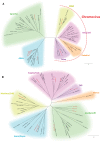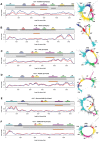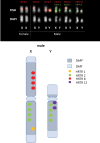Satellite DNA and Transposable Elements in Seabuckthorn (Hippophae rhamnoides), a Dioecious Plant with Small Y and Large X Chromosomes
- PMID: 28057732
- PMCID: PMC5381607
- DOI: 10.1093/gbe/evw303
Satellite DNA and Transposable Elements in Seabuckthorn (Hippophae rhamnoides), a Dioecious Plant with Small Y and Large X Chromosomes
Abstract
Seabuckthorn (Hippophae rhamnoides) is a dioecious shrub commonly used in the pharmaceutical, cosmetic, and environmental industry as a source of oil, minerals and vitamins. In this study, we analyzed the transposable elements and satellites in its genome. We carried out Illumina DNA sequencing and reconstructed the main repetitive DNA sequences. For data analysis, we developed a new bioinformatics approach for advanced satellite DNA analysis and showed that about 25% of the genome consists of satellite DNA and about 24% is formed of transposable elements, dominated by Ty3/Gypsy and Ty1/Copia LTR retrotransposons. FISH mapping revealed X chromosome-accumulated, Y chromosome-specific or both sex chromosomes-accumulated satellites but most satellites were found on autosomes. Transposable elements were located mostly in the subtelomeres of all chromosomes. The 5S rDNA and 45S rDNA were localized on one autosomal locus each. Although we demonstrated the small size of the Y chromosome of the seabuckthorn and accumulated satellite DNA there, we were unable to estimate the age and extent of the Y chromosome degeneration. Analysis of dioecious relatives such as Shepherdia would shed more light on the evolution of these sex chromosomes.
Keywords: chromosomal localization; genome composition; repetitive DNA; sex chromosomes.
© The Author(s) 2017. Published by Oxford University Press on behalf of the Society for Molecular Biology and Evolution.
Figures








Similar articles
-
Contrasting patterns of transposable element and satellite distribution on sex chromosomes (XY1Y2) in the dioecious plant Rumex acetosa.Genome Biol Evol. 2013;5(4):769-82. doi: 10.1093/gbe/evt049. Genome Biol Evol. 2013. PMID: 23542206 Free PMC article.
-
Survey of repetitive sequences in Silene latifolia with respect to their distribution on sex chromosomes.Chromosome Res. 2008;16(7):961-76. doi: 10.1007/s10577-008-1254-2. Epub 2008 Oct 15. Chromosome Res. 2008. PMID: 18853265
-
Low coverage sequencing for repetitive DNA analysis in Passiflora edulis Sims: citogenomic characterization of transposable elements and satellite DNA.BMC Genomics. 2019 Apr 2;20(1):262. doi: 10.1186/s12864-019-5576-6. BMC Genomics. 2019. PMID: 30940088 Free PMC article.
-
Plant sex chromosomes: molecular structure and function.Cytogenet Genome Res. 2008;120(3-4):255-64. doi: 10.1159/000121075. Epub 2008 May 23. Cytogenet Genome Res. 2008. PMID: 18504355 Review.
-
The role of repetitive DNA in structure and evolution of sex chromosomes in plants.Heredity (Edinb). 2009 Jun;102(6):533-41. doi: 10.1038/hdy.2009.17. Epub 2009 Mar 11. Heredity (Edinb). 2009. PMID: 19277056 Review.
Cited by
-
Satellite DNA evolution: old ideas, new approaches.Curr Opin Genet Dev. 2018 Apr;49:70-78. doi: 10.1016/j.gde.2018.03.003. Epub 2018 Mar 23. Curr Opin Genet Dev. 2018. PMID: 29579574 Free PMC article. Review.
-
Occurrence of subdioecy and scarcity of gender-specific markers reveal an ongoing transition to dioecy in Himalayan seabuckthorn (Hippophae rhamnoides ssp. turkestanica).Heredity (Edinb). 2019 Jan;122(1):120-132. doi: 10.1038/s41437-018-0084-z. Epub 2018 May 4. Heredity (Edinb). 2019. PMID: 29725078 Free PMC article.
-
Variable resource allocation pattern, biased sex-ratio, and extent of sexual dimorphism in subdioecious Hippophae rhamnoides.PLoS One. 2024 Apr 18;19(4):e0302211. doi: 10.1371/journal.pone.0302211. eCollection 2024. PLoS One. 2024. PMID: 38635726 Free PMC article.
-
Sexy ways: approaches to studying plant sex chromosomes.J Exp Bot. 2024 Sep 11;75(17):5204-5219. doi: 10.1093/jxb/erae173. J Exp Bot. 2024. PMID: 38652048 Free PMC article. Review.
-
Carica papaya L. sex chromosome review and physical mapping of the serk 2, svp-like and mdar 4 sequences.Sci Rep. 2024 Jun 27;14(1):14830. doi: 10.1038/s41598-024-65880-x. Sci Rep. 2024. PMID: 38937542 Free PMC article.
References
-
- Alexandrov OS, Karlov GI. 2016. Molecular cytogenetic analysis and genomic organization of major DNA repeats in castor bean (Ricinus communis L.). Mol Genet Genomics 291:775–787. - PubMed
-
- Altschul SF, Gish W, Miller W, Myers EW, Lipman DJ. 1990. Basic local alignment search tool. J Mol Biol. 215:403–410. - PubMed
Publication types
MeSH terms
Substances
LinkOut - more resources
Full Text Sources
Other Literature Sources

